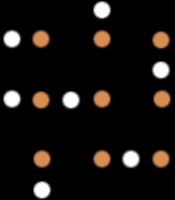Problem Statement |
| | This problem contains images best viewed from the applet.
You are given several points on the plane. Nine points form a 3x3 subgrid if they are
situated on the vertices of a 2x2 rectangle of equal size squares. The sides of the rectangle
must be parallel to the coordinate axes.

The orange points form a subgrid among all the points on the picture.
You are given int[]s x and y, where (x[i], y[i]) are the coordinates of the i-th point on the plane. The points are distinct. Return the number of distinct subgrids you can create with these points. Two subgrids are distinct if one contains a point that is not contained in the other.
|
| |
Definition |
| | | Class: | SubgridsCounter | | Method: | howMany | | Parameters: | int[], int[] | | Returns: | int | | Method signature: | int howMany(int[] x, int[] y) | | (be sure your method is public) |
|
| |
|
| |
Constraints |
| - | x will contain between 1 and 50 elements, inclusive. |
| - | x and y will contain the same number of elements. |
| - | Each element of x will be between -1000 and 1000, inclusive. |
| - | Each element of y will be between -1000 and 1000, inclusive. |
| - | All points represented by (x[i], y[i]) will be distinct. |
| |
Examples |
| 0) | |
| | {0,0,0,0,1,1,1,1,2,2,2,2,3,3,3,3} | {0,1,2,3,0,1,2,3,0,1,2,3,0,1,2,3} |
| Returns: 4 | This is a 4x4 regular grid.
 |
|
|
| 1) | |
| | {7,0,14,0,7,14,14,0,7} | {14,0,14,14,7,7,0,7,0} |
| Returns: 1 | | This is a 3x3 grid. It forms the only subgrid by itself. |
|
|
| 2) | |
| | {6,6,3,0,0,3,0,3,6,1,2} | {6,3,0,0,6,3,3,6,0,1,2}
|
| Returns: 1 | |
|
| 3) | |
| | {6,0,4,0,20,0,0,4,12,6,6,12,12,6,0,12,4,6,4,4,20,20,20,6,6,4,20,4,20,12,12,0,12,0,20} | {4,10,10,9,10,25,0,16,25,0,18,0,4,10,4,16,4,16,25,18,9,4,18,9,25,0,0,9,25,9,18,16,10,18,16} |
| Returns: 1 | |
|

